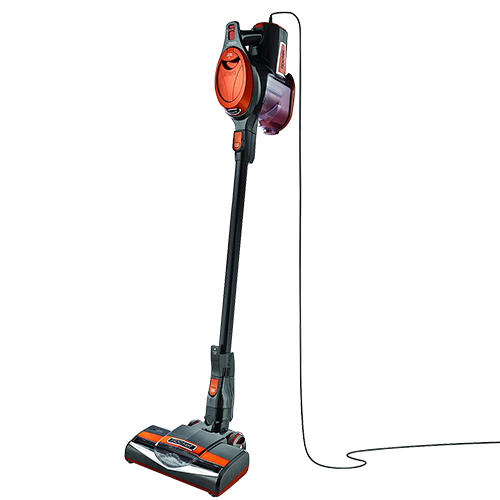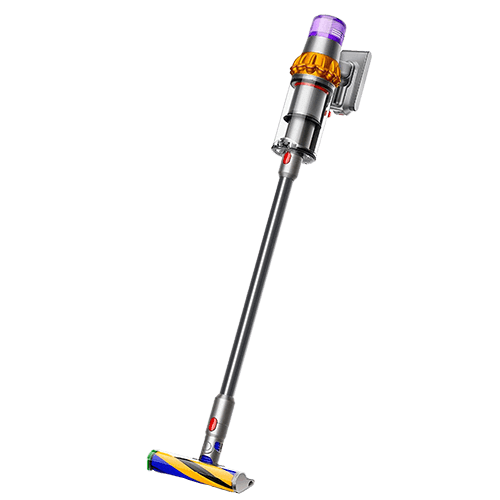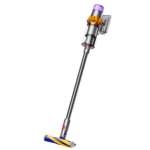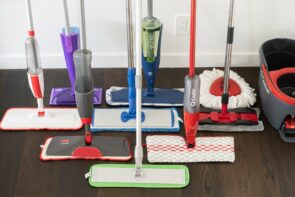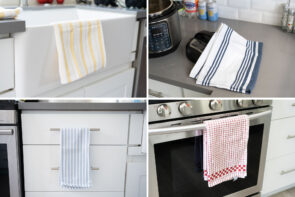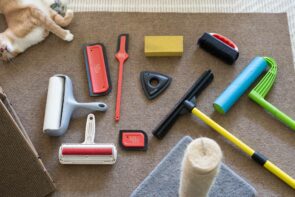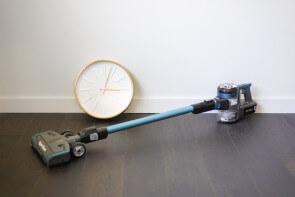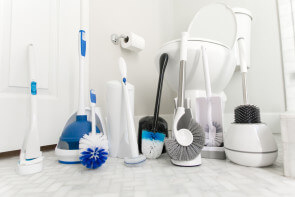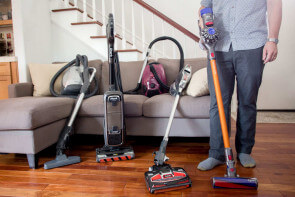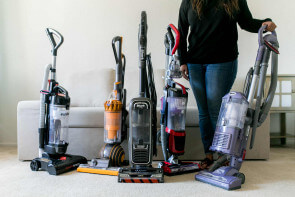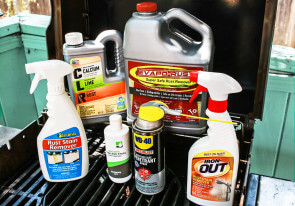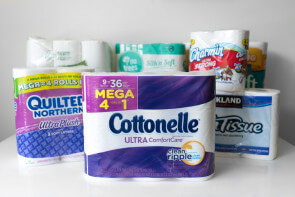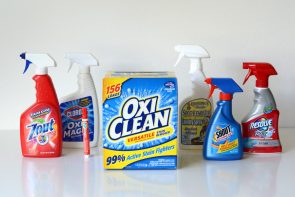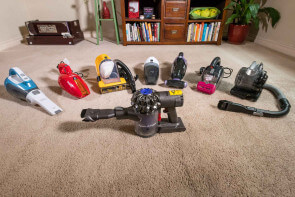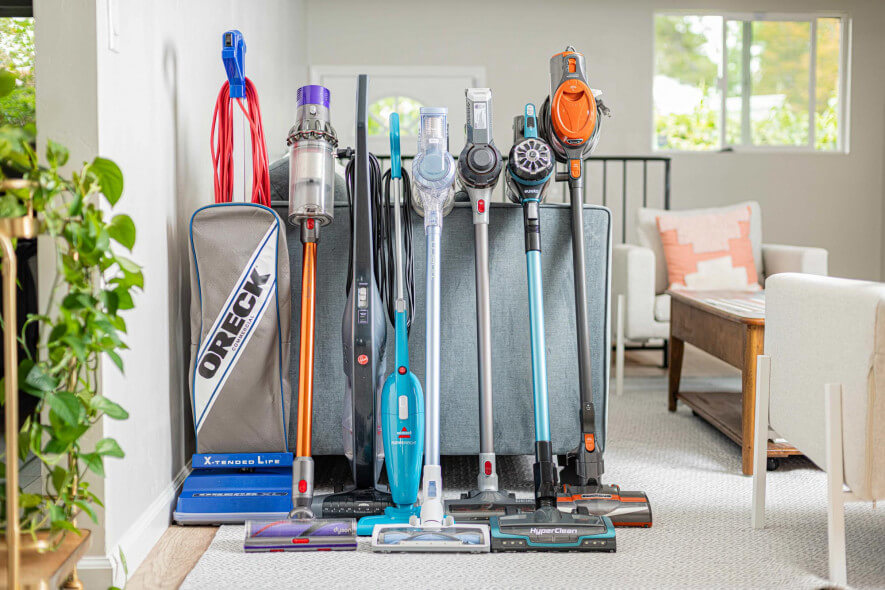
The Best Lightweight Vacuums
We spent 25 hours on research and six weeks testing each of the vacuums in a home environment. We chose the Shark – Rocket HV302 as our pick for the best lightweight vacuum. Weighing just 8 pounds (the average vacuum weighs 14 to 17 pounds), it is one of the more powerful vacuums we tested. If you want a cordless model, we found the Eureka – NEC222 to be the best option. It pulls up an impressive amount of debris and has swivel steering that makes it easy to navigate around furniture. If you don’t mind the hefty price tag, the Dyson – V15 Detect is one of the most technologically advanced vacuums on the market.
We spent 25 hours on research and six weeks testing each of the vacuums in a home environment. We chose the Shark – Rocket HV302 as our pick for the best lightweight vacuum. Weighing just 8 pounds (the average vacuum weighs 14 to 17 pounds), it is one of the more powerful vacuums we tested. If you want a cordless model, we found the Eureka – NEC222 to be the best option. It pulls up an impressive amount of debris and has swivel steering that makes it easy to navigate around furniture. If you don’t mind the hefty price tag, the Dyson – V15 Detect is one of the most technologically advanced vacuums on the market.
Table of contents
- The 10 lightweight vacuums we tested
- Best corded: Shark – Rocket HV302
- Best cordless: Eureka – NEC222
- Upgrade pick: Dyson – V15 Detect
- Other products we tested
- How we selected
- How we tested
- Important features to consider
- The bottom line
The 10 lightweight vacuums we tested
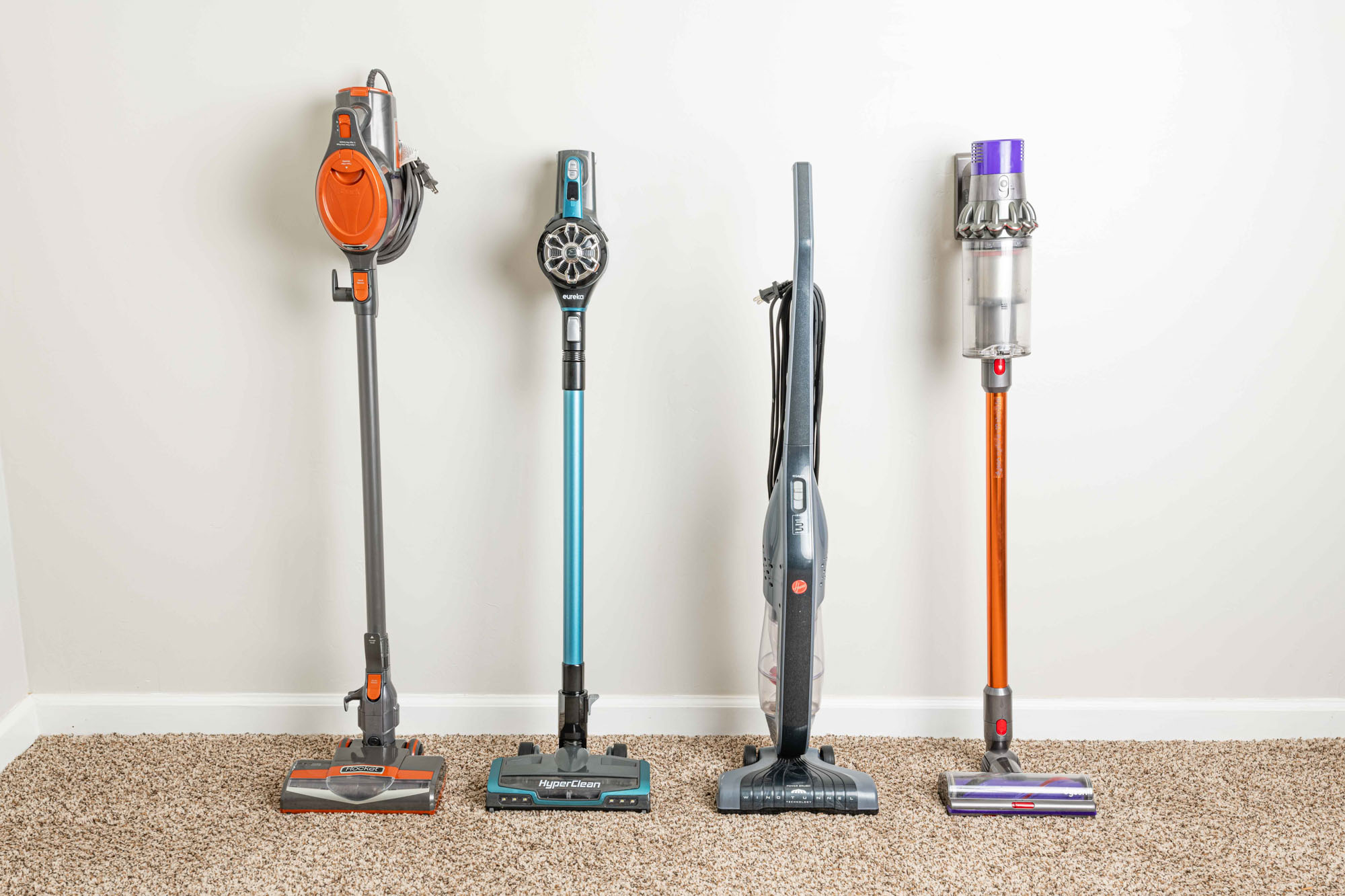
| Product | Price | Style | Weight (lbs) | Converts to Handheld |
|---|---|---|---|---|
| Shark - Rocket HV302 | $$$ | Corded | 8.2 | Yes |
| Eureka - NEC222 | $$$ | Cordless | 6.5 | Yes |
| Dyson - V15 Detect | $$$$ | Cordless | 6.8 | Yes |
| Dyson - V11 Torque Drive | $$$$ | Cordless | 6.7 | Yes |
| Dyson - V10 Absolute | $$$$ | Cordless | 5.9 | Yes |
| Oreck - XL2100RHS | $$$ | Corded | 8.2 | No |
| Tineco - A11 Hero | $$$$ | Cordless | 5.5 | Yes |
| Bissell - Featherweight 2033 | $ | Corded | 3.0 | Yes |
| Deik - ZB1516 (Discontinued) | $$$ | Cordless | 4.7 | Yes |
| Hoover - SH20030 (Discontinued) | $$ | Corded | 8.0 | No |
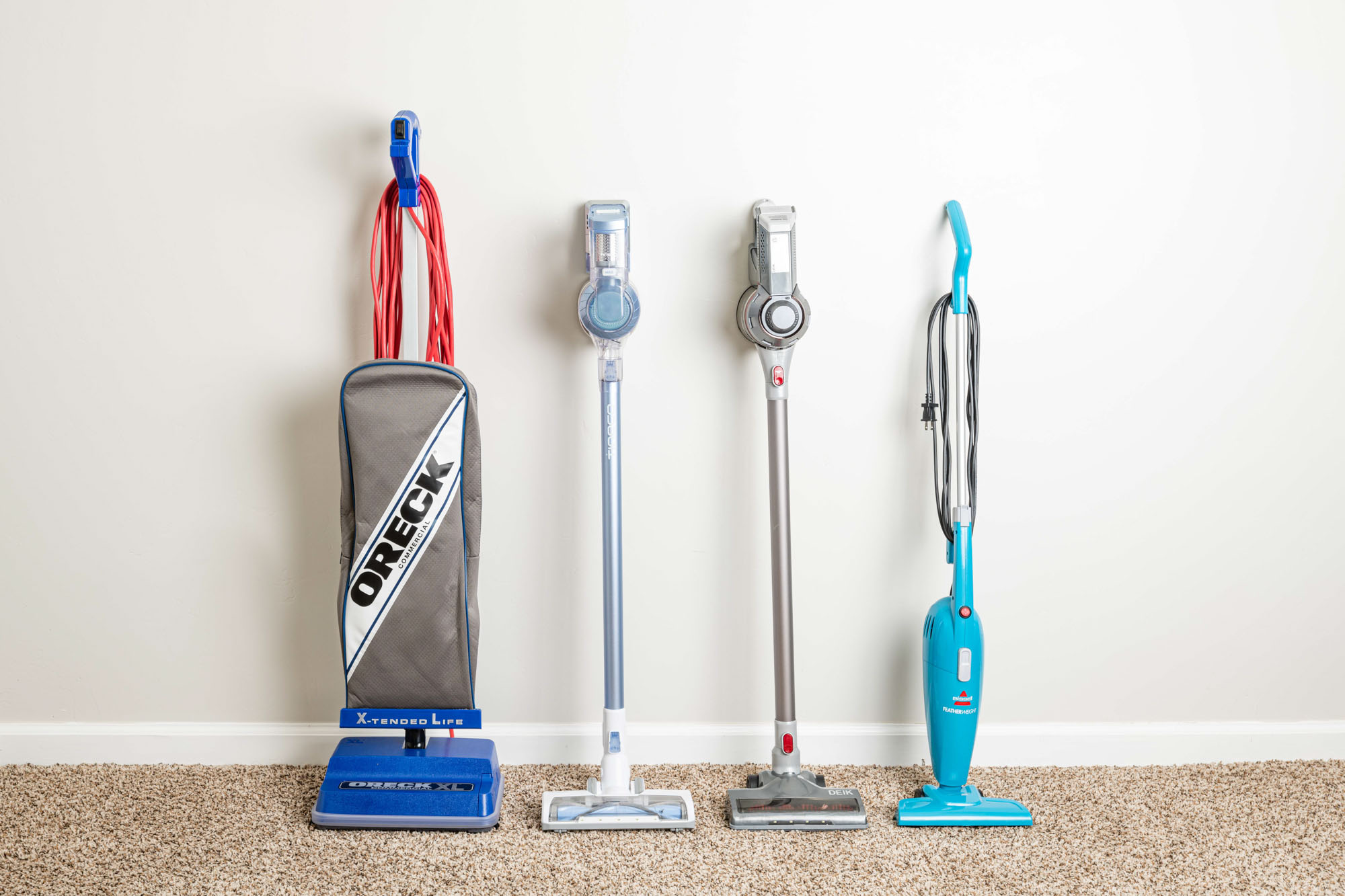
Best corded: Shark – Rocket HV302
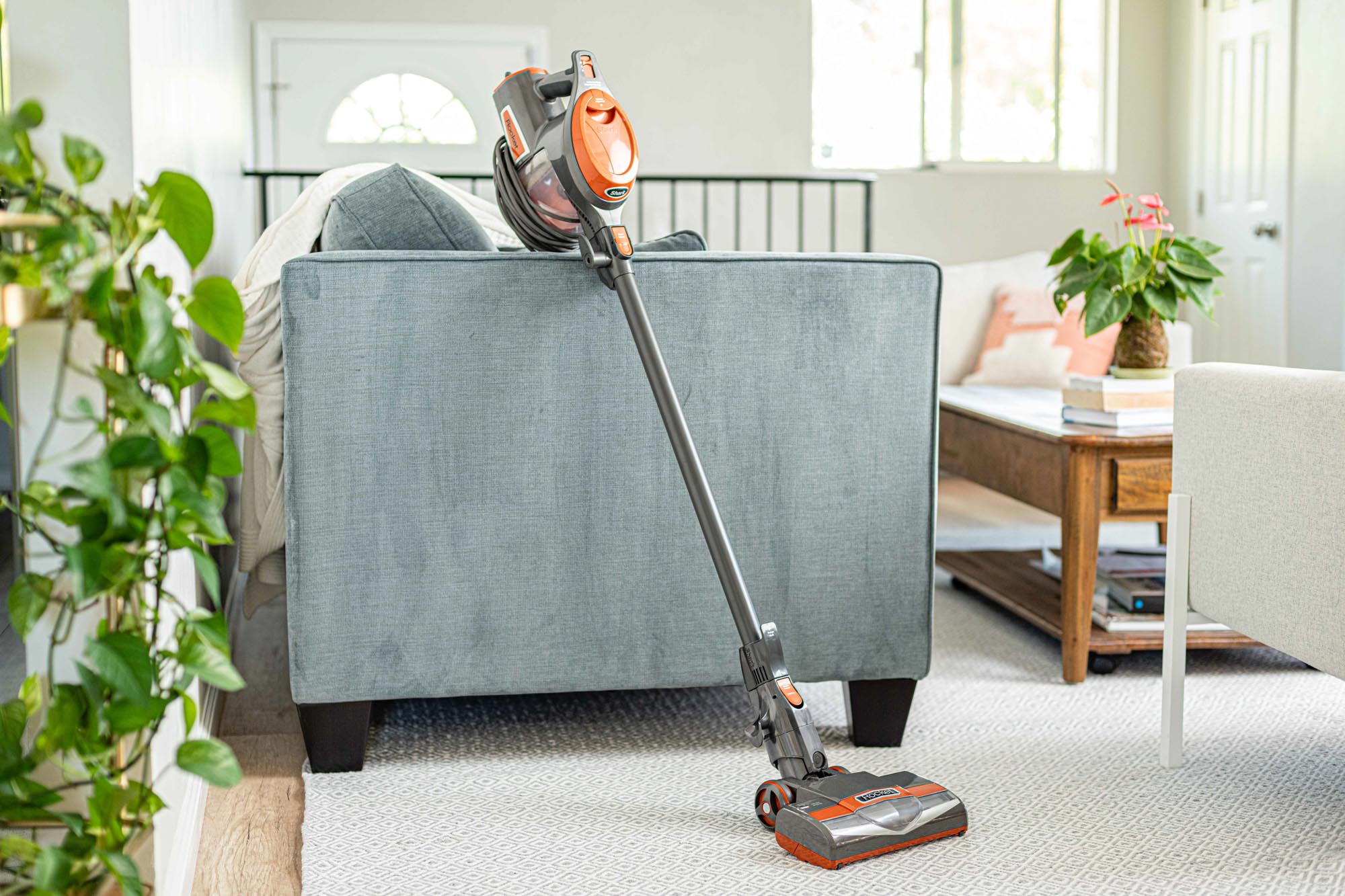
In our tests, we found the vacuums with better suction tended to be harder to move around the floor. The Shark – Rocket HV302 is the exception; the power and the motorized brush roll work together to make it feel as though it is self-propelled. Swivel steering adds even greater agility, making the Shark easy to navigate around furniture. The combination of power and maneuverability made the Shark our top choice for a lightweight vacuum.
The Shark doesn’t snowplow large debris and is excellent at pulling up dirt and debris from along wall edges. The filter is simple to reach and remove using a flip-top lid and the waste canister is easy to empty. It has a 30-foot cord, so it’s easy to reach across the room and even down the hallway, depending on the size of your rooms.
Although it doesn’t have a HEPA filter, the Shark performed on par with the Dyson in terms of emissions (and the Dyson is priced three times higher). It lowered both the large particle count and small particle count in the room after vacuuming. It pulled up sand and fine debris in large amounts, impressing us with how clean the floor looked after vacuuming with the Shark.
The motorized brush roll helps to agitate dirt from carpets, while the included Hard Floor Hero head serves to pick up surface litter and stuck-on food or dirt. So you have the option to adjust the height with a switch and keep vacuuming across different floor types or change out the vacuum head.
This model converts into a hand vacuum with a dusting brush, upholstery brush and crevice tool. It also comes with a car-detail kit with micro tools for detailing your automobile.
Things we didn’t like
As powerful as the Shark is, it didn’t fare well in our pet hair test. For a better option, see our review on vacuums for pet hair. In fact, the power may have been part of the problem. It sucked up so much pet hair at one time that within 30 seconds the filter was too clogged to retain any more debris.
The other downside is that it is one of the heavier finalists we tested. Although it only weighs eight pounds, the majority of the weight is in the handheld portion of the vacuum. It may not be the best choice for you if your wrist is easily strained. Because it is so top heavy, it also doesn’t stand up on its own.
However, you can mount it on the included wall bracket for storage. You can also detach the hand vac from the floor mount and place it on the hook above the floor nozzle for easy storage.
These considerations aside, the Shark has enough pros that we feel comfortable recommending it as our top choice for a corded lightweight vacuum.
Key takeaways:
- The Shark – Rocket HV302 is easy to use and maneuver, as the combination of strong suction and a motorized brush head reduces the force needed to push the vacuum.
- Swivel steering makes vacuuming around furniture effortless, and a low profile allows you to reach under couches easily.
- Our air was cleaner after vacuuming with the Shark, as its tightly sealed system and effective filter trapped fine and larger dust particles while running.
- This model may not be the best choice for pet owners, as pet hair tends to clog in the filter and reduce efficacy.
Best cordless: Eureka – NEC222
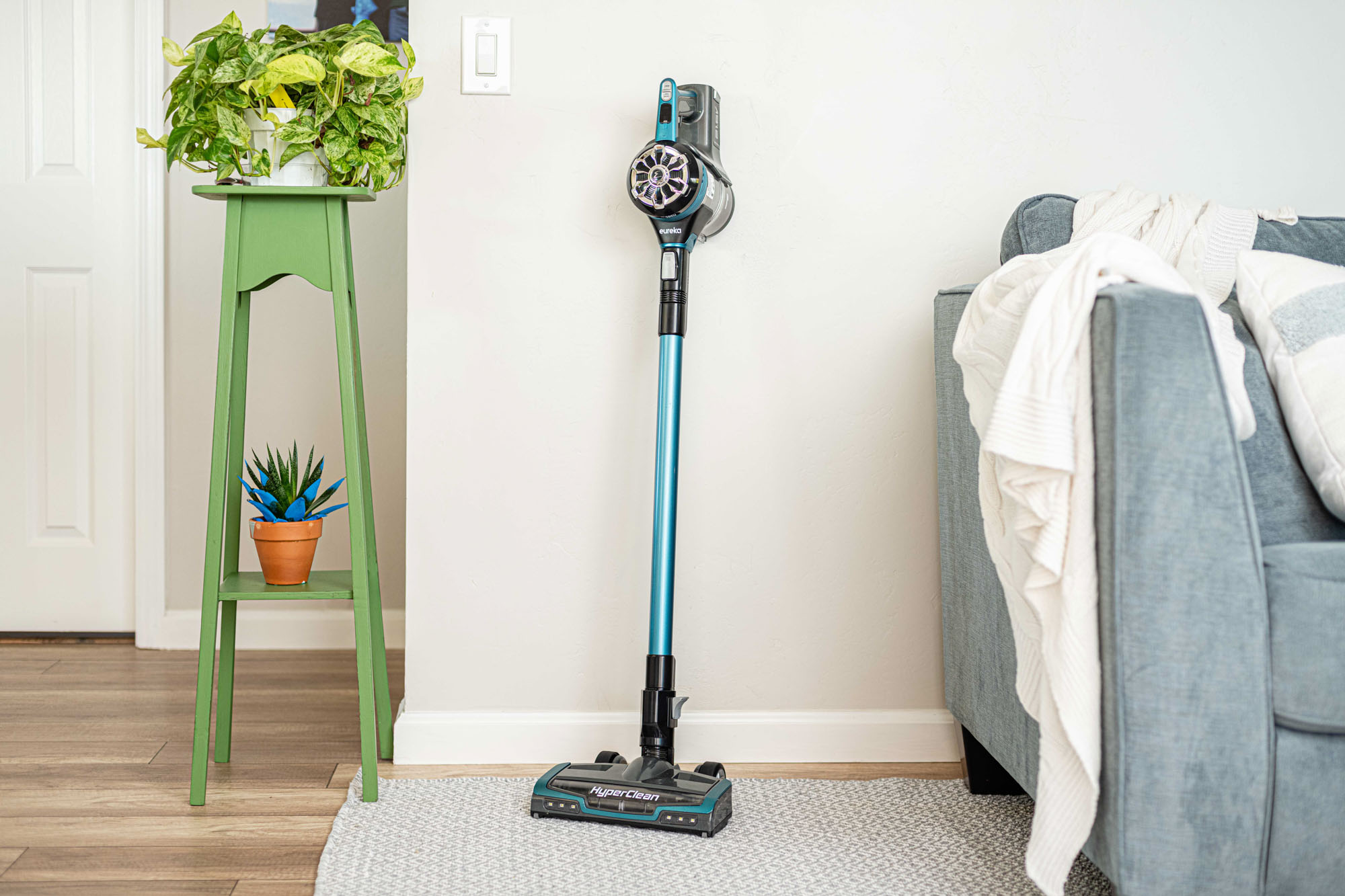
Priced lower than average, especially for a cordless model, the Eureka – NEC222 is well worth the investment of a high-end vacuum. It is quiet but powerful and swivel steering makes it a breeze to move around the room. The low profile makes it a snap to clean underneath furniture, while its agility makes it easy to get around large pieces.
The Eureka aced our performance test, picking up as many grams of dirt as the Dyson and pulling up embedded pet hair without clogging. While it didn’t clean the air in our emissions test, it also retained any large or fine debris it pulled up from the carpet so you don’t have to worry about dust kickback.
It has the brightest front headlights, making it easy to see in low lighting. The waste canister empties at the touch of a button; there’s also a second option to twist off the collection cup.
The things we liked most about this vacuum were its performance on both pet hair and fine dust and its quiet motor. The Eureka is only 6.5 pounds, so despite the motor being located at the handle, it didn’t put any pressure on our wrist.
The vacuum converts into a hand vac and comes with a crevice tool and a two-in-one upholstery tool. It has a solid 30 minutes of run time and charges in four hours.
Things we didn’t like
Our main concern with the Eureka is that the controls aren’t easily decipherable, so it’s hard to determine which symbol means carpet and which means hard floors (without consulting the manual, and let’s face it, we all know those end up in a junk drawer and are rarely consulted).
A secondary issue is that the brush head tends to lift off the ground, so it doesn’t always make full contact with the floor. This could mean it doesn’t pick up as much as it should or that you have to make multiple passes over the same area, unless you are actively ensuring that it fully engages with the carpet or hard flooring.
Key takeaways:
- The Eureka – NEC222 is reasonably priced for a lightweight cordless vacuum and well worth the expense.
- If you want a lightweight cordless vacuum that rivals the Dyson in terms of performance and doesn’t kick back any dust, the Eureka is an excellent choice.
- At 6.5 pounds, it’s so lightweight that the brush head tends to lift off the carpet, but it doesn’t cause any arm fatigue after a long period of vacuuming.
- Despite being a powerful vacuum, the Eureka is one of the quietest models we tested.
Upgrade Pick: Dyson – V15 Detect
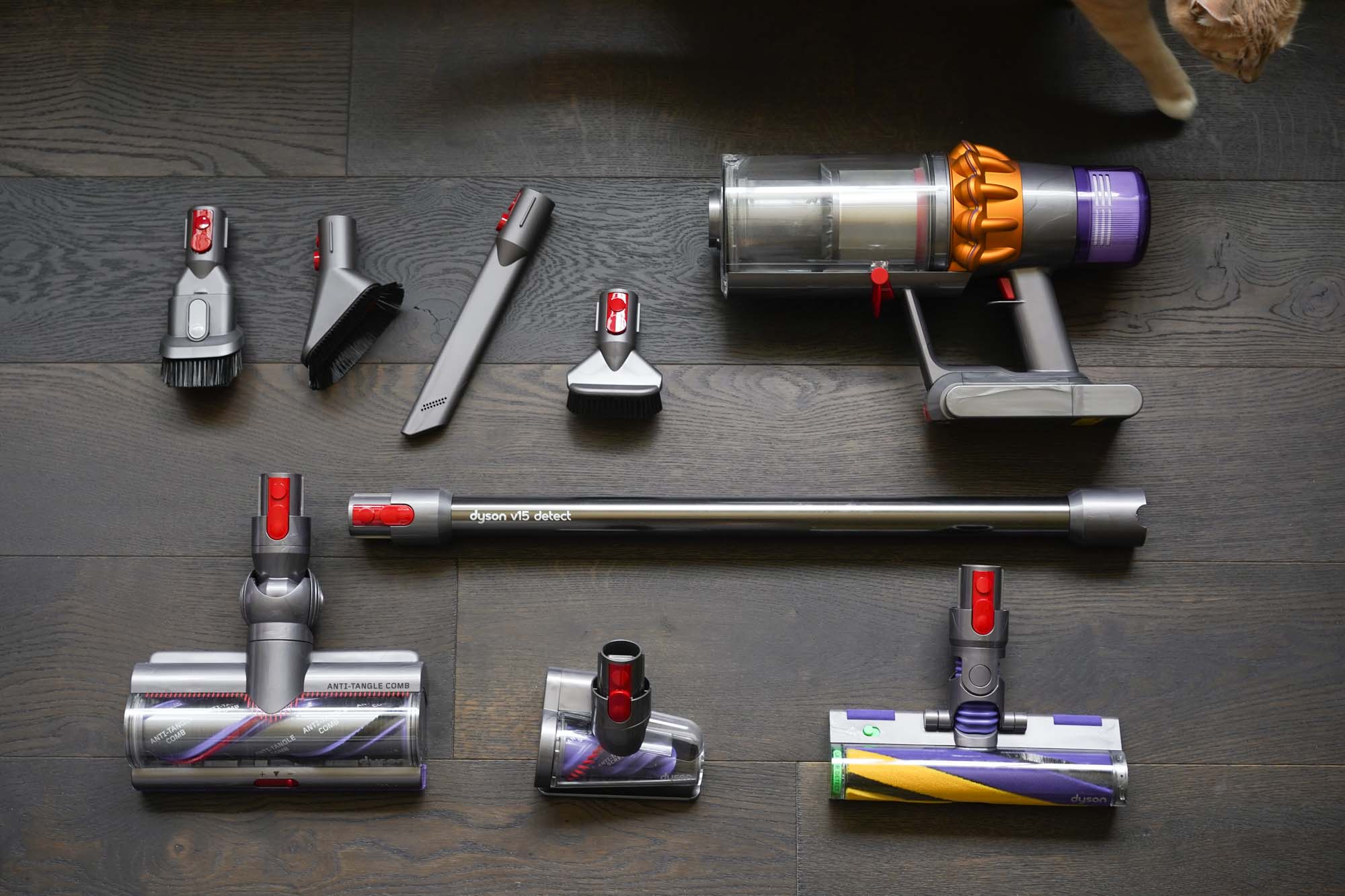
If you suffer with allergies from dust, pollen, and pet dander, we highly recommend the Dyson – V15 Detect. It’s about $700, and that might be a deterrent to purchasing one, but in our estimation, the investment is worth it. At 6.8 pounds, it’s just 3 ounces heavier than our best cordless pick, the Eureka – NEC222. Dyson improves on its previous models with a couple of additions. First, it has 20% more power, meaning, the vacuum’s suction is even greater.
The improved digital display allows you to select Eco, Auto, and Boost modes, and how much the charge remains. For Eco, it’s 60 minutes, for Auto (it automatically detects the floor surface you’re vacuuming), it’s 45 minutes, and for Boost, it’s 7.5-8 minutes. The latest add-on to the display is a Piezo sensor bar graph that shows how many allergens, microscopic dust, dust mites, and larger debris (for pet lovers, this includes fleas) are vacuumed. With first use, you may be shocked by how high the numbers are. During our testing, the living room area picked up an astounding 490 million allergens. You’ll get accustomed to the high levels, which, of course, you had no idea were there, and will appreciate that the Dyson is sucking them all up.
It also comes with several nifty attachments. The large torque head is excellent for vacuuming pet hair because its anti-tangle comb prevents hair from getting trapped. The smaller torque head works well with stairs since it automatically adjusts to when you’re vacuuming the top of the stair and the back of the stair. The most touted new feature in the V15 is the Laser Slim Fluffy cleaning head that showers the floor with a green laser, illuminating dust and dirt in dimly lit areas.
The V15 converts to a handheld, and the included brushes and tools let you get into tight corners above and below, between cushions, and on top of draperies. With the mini torque head, the V15 is great for vacuuming the car, particularly the seats and floor mats. Depending on the size of your home, you could vacuum every surface and then have enough charge to do the car. The Dyson V15 Detect is not for the budget-conscious, but if you can afford to upgrade, then this is the lightweight vacuum you should consider buying.
Key takeaways:
- The Dyson V15 Detect is one of the most powerful lightweight vacuums we tested and can last up 60 minutes on one charge.
- Its Piero sensor display shows how many millions of allergens, dust, dust mites, and small debris you vacuum up.
- Like all Dyson products, the V15 is expensive, but if you suffer from allergies, it would be worth the investment.
Other products we tested
Dyson – V11 Torque Drive
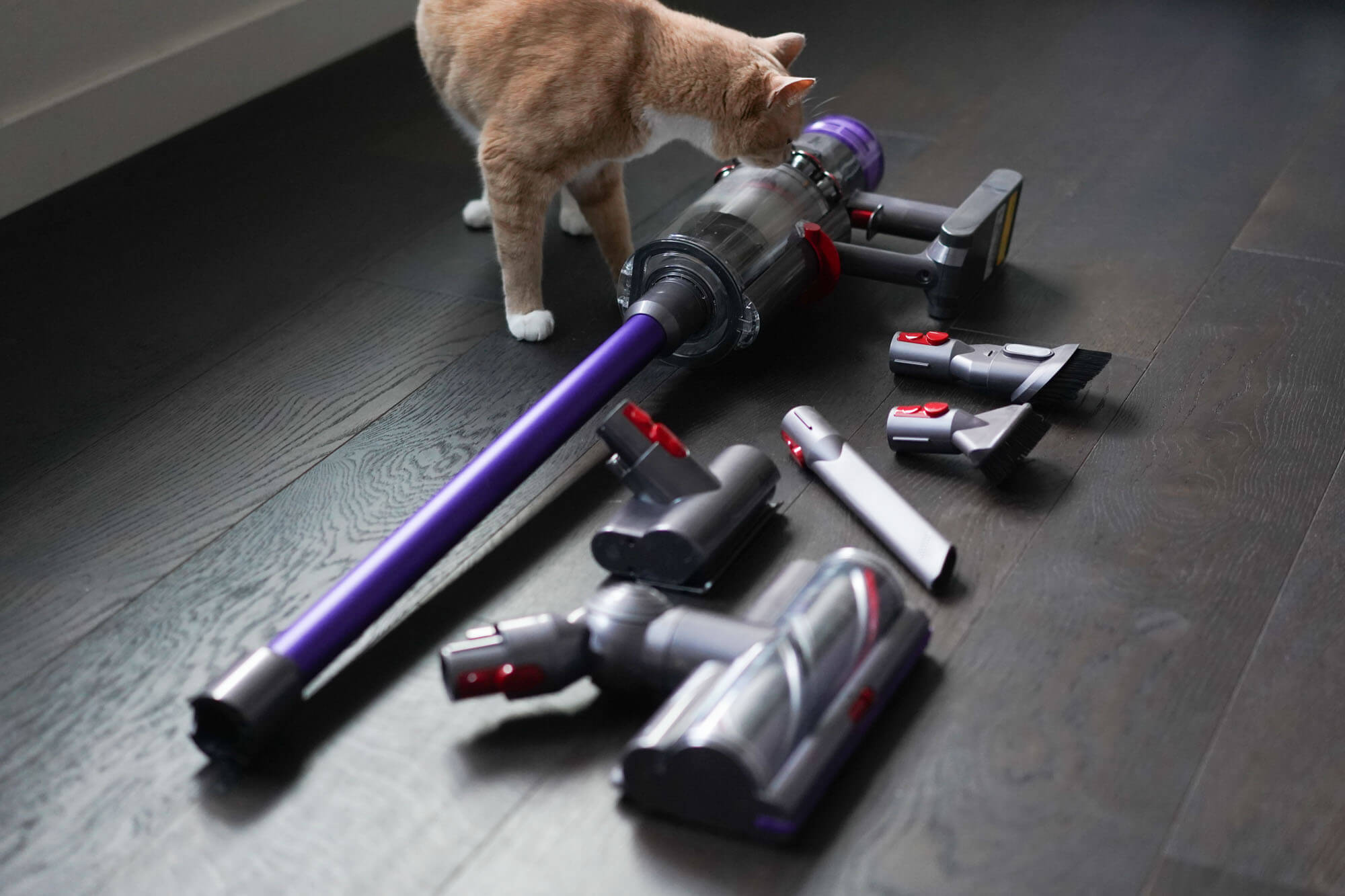
With the release of the Dyson – V11 Torque Drive, Dyson cleared up a few of the problems we had with the Dyson – V10 Absolute. The major upgrade is the new torque cleaner head, which not only propels the vacuum forward, it also automatically detects the floor type — carpet, hardwood, tile — and adjusts the motor to clean the floor type more efficiently. During our testing, we ran the vacuum over several floor types and materials (couch upholstery, dog beds), and the detection and adjustment happened almost immediately. As much as we liked the torque drive’s propulsion, it also made the V11 a little tricky to steer. Still, having that much power made vacuuming a breeze.
The other addition to the V11 is the LCD screen that displays how much charge is remaining in the battery and vacuuming mode: Eco, Auto, and Boost. Eco will give you about 60 minutes of run time and Normal 45 minutes. Boost will suck the charge out of the battery in 10-12 minutes, so it should only be used to tackle ground-in dirt and debris.
The V11 weighs about a pound (6.7) more than the V10 (5.9), and that extra weight did tire our hands when we were vacuuming stairs, ceiling corners, and car interior. The Dyson V11 is pretty expensive at the moment and can even cost more than the V15, which is more available. But you can get a more reasonably priced V11 that’s been completely refurbished by Dyson.
Dyson – V10 Absolute
We previously recommended the Dyson – V10 Absolute, and although its price point is more than double the average cost of our vacuums, every Dyson we have tested (including the V10 Absolute) outperforms the other finalists in terms of performance and air quality.
We didn’t name it our winner simply because it isn’t as easy to maneuver as our top picks, and we considered agility a top priority for a lightweight vacuum. The price point is higher than many consumers are able or willing to spend. Finally, we noted that the hygienic one-touch emptying bin tends to stick, making it more likely to spill the contents. (This wasn’t an issue with other Dyson models we previously tested.)
However, if you have pets or allergies, it may be worth it to invest in a Dyson for its ability to capture and retain both pet hair and dander. Dyson cord-free vacuums have whole machine filtration which captures 99 percent of particles as small as 0.3 microns.
Oreck – XL2100RHS
The Oreck – XL2100RHS is a bagged, corded and commercial model that performs extremely well in terms of pulling up embedded dirt and debris from carpet. It has plenty of power, but it’s also the noisiest vacuum of the models we tested. It also tends to drag along the floor and doesn’t have swivel steering, so although it weighs the same as the Shark, it causes arm fatigue, and the Shark doesn’t.
If you want a powerhouse vacuum and your main reason for choosing a lightweight vacuum is the ability to carry it upstairs easily, the Oreck is a good choice. However, if you have allergies or asthma, the trail of dust it leaves behind may make the Oreck a poor choice for you.
Tineco – A11 Hero
If maneuverability is what you prize most, the Tineco – A11 Hero is hands down the most agile vacuum we tested. Unfortunately, it doesn’t possess the suction power to name it as our top cordless pick. It only picked up four grams of dirt in our performance test, and appeared to pick up large debris well (with no snow plowing), but would leave pieces behind after we turned off the suction.
It comes with two lithium-ion batteries and a dual charging dock, so you can run the vacuum for up to 60 minutes without interruption. The waste canister is easy to empty, and it is easy on the wrist at only 5.5 pounds, despite being top heavy.
Deik – ZB1516
The Deik – ZB1516 has swivel steering, but the brush head doesn’t move as easily as our other contenders with swivel steering. Although it’s a top-heavy model like most of our lightweight cordless vacuums, the Deik weighs only 4.7 pounds so you don’t feel strain on the wrist.
It has a HEPA filter, but it tested as one of the neutral models in our emissions test. It doesn’t leave the air cleaner like the Shark or Dyson, but it doesn’t kick back dust either. Our overall impression of the Deik is neutral. At just over half the price of the average cost of our finalists, there isn’t anything negative about this vacuum, but it doesn’t have many standout qualities either.
Bissell – Featherweight 2033
If you need the absolute lightest vacuum for quick pick-ups, the Bissell – Featherweight 2033 is a decent option. It lies flat so you can get underneath furniture easily, although the head doesn’t swivel so it doesn’t navigate as well as other finalists. However, at only 3 pounds, maneuverability isn’t as much of an issue as it would be for heavier vacuums.
The short cord could be problematic if you have a larger area room, and the filter clogs easily with pet hair. For the price and weight, these issues may not be deal-breakers. The Bissell is the lowest-priced model we tested, and although it doesn’t come with any bells or whistles or have much power, it will make your floor appear cleaner with minimal effort.
Hoover – SH20030 (Discontinued)
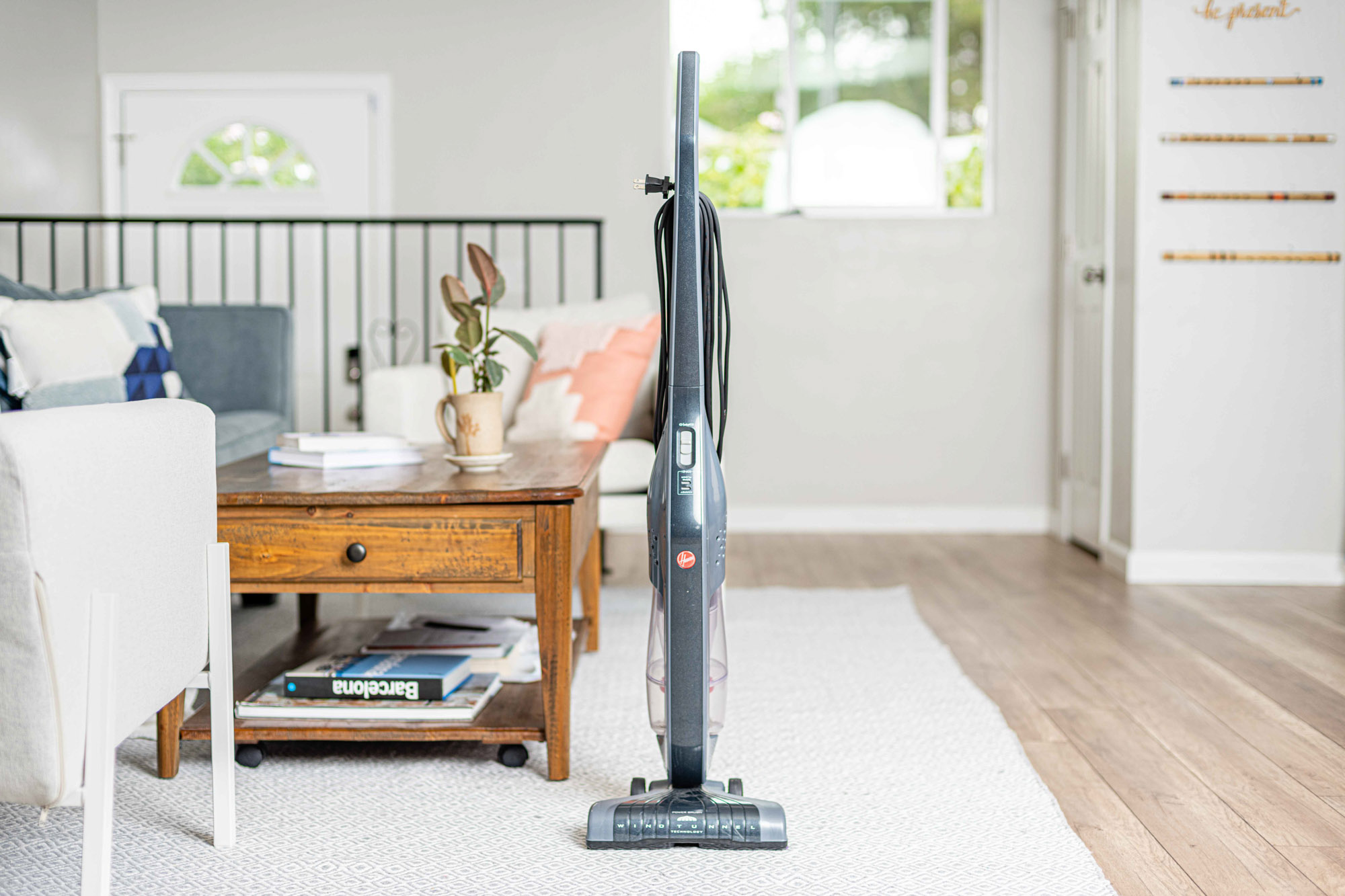
(Editor’s note: The Hoover – SH20030 has been discontinued and replaced with a newer model, Hoover – BH53420PC, ONEPWR Evolve.)
The Hoover – SH20030 wasn’t the absolute lowest-priced model we tested. However, it was the best performing vacuum on the lower end of the price spectrum. It easily picked up pet hair and cereal in our performance test, and we especially liked that it could pick up debris along the edges of walls (thanks to edge cleaning bristles on the brush roll). It didn’t deep clean as well as our other top picks, but it would be an excellent second vacuum for a quick pick up.
It ran smoothly on hard floors and didn’t snowplow large debris, and we easily transitioned between flooring types with a flick of the switch. It had a low profile and reached under furniture with no problem. The swivel steering was useful for navigating around furniture and getting close to the edges.
Weighing only eight pounds, the weight was evenly distributed, so it was easier to handle than our top-heavy cordless vacuums. Its 20-foot cord was long enough to reach across most rooms.
We also liked that the Hoover is on the quieter side at only 75.9 dBA, less than our average rating of 79.4 across all models we tested. It’s also slim and stores upright, which makes it convenient to keep close at hand for those quick pick-up jobs.
Things we didn’t like
The Hoover performed better picking up large debris than fine dust. It’s a good choice for a lightweight, everyday vacuum, but if you’re looking for a vacuum that really deep cleans, you may want to look elsewhere.
It didn’t spew out fine particles (perhaps because it doesn’t pull them out of the carpet in the first place), but it did have trouble retaining large particles. If you have allergies or breathing issues, you may want to upgrade to a model with a more tightly sealed system.
How we selected
Since a vacuum weighing more than 15 pounds can cause arm fatigue when pushed around large spaces or carried upstairs, we limited our scope to vacuums weighing 15 pounds and under. Corded vacuums tend to be more powerful, while cordless ones are more convenient. Keeping this in mind, we searched for the best options in each category.
We’ve tested multiple types of vacuums here at Your Best Digs, as we searched for everything from the best upright vacuum to the best handheld vacuum. These previous experiences have given us a good sense of overall features to consider when also factoring in a lightweight aspect.
For instance, we considered the fact that swivel steering can greatly impact the amount of work it takes to move a vacuum around. If you’re choosing a lightweight vacuum because you want to ease the strain of pushing a heavy vacuum around, this is an important feature to note.
We looked at reputable sources such as Consumer Reports and Wirecutter to gather information about the top lightweight vacuums on the market. Once we narrowed down a list of finalists that had the features we deemed most important, we culled the list further based on Amazon reviews and reports from the Laundry Love & Cleaning Science Facebook group.
How we tested
| Product | Maneuverability | Maximum Sound (dB) | Filter Contents (grams of dust, sand, pet hair) | Overall Emissions Rating |
|---|---|---|---|---|
| 1. Shark - Rocket HV302 | ☆☆☆☆☆ | 83.5 | 5 | ☆☆☆☆☆ |
| 2. Eureka - NEC222 | ☆☆☆☆☆ | 71.3 | 9 | ☆☆☆☆ |
| 3. Hoover - SH20030 | ☆☆☆☆ | 75.9 | 2 | ☆☆☆ |
| 4. Dyson - V10 Absolute | ☆☆☆☆ | 85.0 | 9 | ☆☆☆☆☆ |
| 5. Oreck - XL2100RHS | ☆☆ | 88.6 | 14 | ☆ |
| 6. Tineco - A11 Hero | ☆☆☆☆☆ | 77.2 | 4 | ☆☆☆☆ |
| 7. Deik - ZB1516 | ☆☆☆☆☆ | 80.1 | 6 | ☆☆☆☆ |
| 8. Bissell - Featherweight 2033 | ☆☆☆ | 74.0 | 3 | ☆☆ |
Performance
We tested in a household with three children and three pets — two dogs and a domestic shorthair cat — and the carpet was embedded with pet hair. We added sand, baking soda (to mimic fine dust), and cereal (large debris) to the mix. Starting with empty collection containers, we passed each vacuum over the area for 30 seconds. Then we weighed the output in grams to test how much each vacuum collected.
Pet hair is naturally lighter than sand or cereal, so while we measured the contents of each collection container, we visually inspected the carpet to see if there was any debris remaining. The type of debris collected gave us insight into which vacuums picked up more fine debris and which gathered the most pet hair.
Finally, we performed the same test again on hard flooring. We paid attention to whether or not the vacuums snowplowed (pushed forward rather than sucked up) the large debris.
The Oreck, Dyson, and Eureka were able to capture the most pet hair, sand, and baking soda at the same time without the brush roll or filter becoming clogged. The Shark picked up a large amount of pet hair from the carpet, but the hair wound itself around the filter and created a pressure that caused it to “backfire,” sending larger pieces of debris back onto the carpet.
The Hoover did a good job of picking up surface pet hair and cereal, but it didn’t do much to pull up ground-in dirt and debris from the carpet. It pulled in cereal without snowplowing it across the floor, even better than some of our more expensive finalists. For example, the Tineco wasn’t able to retain larger pieces of debris, leaving them on the floor after we moved the vacuum.
Emissions
The best vacuums are able to keep the dirt contained in their collection bag or cylinder, so the dust and debris aren’t spewed back out into the air. This is especially important if you have allergies. To test filter performance, we measured dust kickback with a Dylos air quality monitor.
The laser countermeasures air quality in terms of both large particles (PM10) and small particles (PM2.5). Particle pollution can be especially harmful to those with asthma, older adults, and babies, and children. Smaller particles are more troublesome because they can get into the deep parts of your lungs.
We took a reading before vacuuming, then measured the air quality again after vacuuming a single room for 10 minutes. Some vacuums, such as the Oreck and the Bissell, caused the numbers to jump dramatically. The Shark and the Dyson actually improved the quality of the air, reducing both large and small airborne particles. The Eureka and Deik were relatively neutral, neither spewing dust nor filtering it out of the air.
Usability
Over the course of six weeks, we used these vacuums to vacuum as any consumer would. We vacuumed in multiple rooms on both hard flooring and carpet for approximately 30 minutes at a time.
Since we wanted to find the best lightweight vacuum, key considerations here were arm fatigue and maneuverability. We rated each vacuum on a scale of one to five (five being best) for ease of use, giving the highest ratings to vacuums that didn’t cause arm fatigue.
We maneuvered each vacuum around the room and judged how easy it was to operate. Then we tested its profile by lying it flat and vacuuming under a couch and living room chairs. We noted features such as button placement and the ability to determine what the settings meant without consulting the manual. Finally, we considered how easy it was to change the filter or empty the waste container.
Our five-star finalists for maneuverability were the Shark, Eureka, Tineco, and Deik. Despite being only 8.2 pounds, the Oreck was incredibly difficult to push around the room. The stronger the suction, the more difficult it was to push — with the exception of the Shark, which feels as if it is propelling forward without effort. Finalists like the Dyson and Tineco were easy to operate, but we encountered resistance on their Max settings and vacuuming became more labor-intensive.
Noise output
For this test, we measured the sound output in decibels of each vacuum using a sound pressure level meter. The ambient noise level of the room measured at 59.3 decibels, with a fan running and someone cooking in the other room. We held the meter at ear level while running each vacuum to gauge the noise exposure while actually using the vacuum.
The average noise level of our finalists was 79 dBA, when the vacuums were used at their highest setting. Comparatively, it’s the sound of a freight train from 100 feet away. Our loudest vacuum, the Oreck, was closer to the sound levels of a boiler room at 88.6 dBA. The Eureka was the quietest vacuum, measuring 71.3 dBA, or a little louder than classroom chatter. The Shark had a wide range of noise levels, from 83.5 dBA on its max setting to just below the average noise level at 77.2 dBA on its lowest setting.
Important features to consider
- Lightweight: Vacuums over 15 pounds become tough to move around, an important consideration if you need to cover more square footage or carry it upstairs. The vacuums we tested weighed 3 to 8 pounds.
- Swivel steering: Maneuverability is key if you’re choosing a vacuum based on its ease of use. Even a lightweight vacuum can cause arm fatigue without swivel steering since you need to make double the effort to guide it around the room.
- Corded vs. cordless: Corded vacuums are typically more powerful than cordless vacuums, although some newer cordless models are nearly as powerful as a corded vacuum.
- Battery life/run time: If you do choose a cordless model, consider how long the battery takes to charge and how long you can run the vacuum before the battery dies.
- Sealed HEPA filter: If you have allergies or asthma, you’ll want to make sure your vacuum traps dust mites, pet dander, and pollen in a tightly sealed system. A vacuum with a sealed HEPA filter must meet the rigorous U.S. HEPA (High Efficiency Particulate Air) standards of removing 99.97 percent of all particles 0.3 microns or larger.
- Low profile: A vacuum that lies flat is able to fit under furniture, which means you can clean without moving heavy objects around the room.
- Easy emptying: Whether using a bagged or bagless model, you should be able to empty the vacuum without dirt escaping.
- Brush roll: A spinning beater brush agitates debris in the carpet for a deeper clean, but on hard floors, it can scratch the surface and fling debris away. A better option for hard flooring is a vacuum that allows you to turn off the beater brush or, better yet, has a soft roller head.
- Converts into a handheld vacuum: A model that converts into a handheld vacuum gives you the most bang for your buck and allows you to use it on multiple cleaning tasks. It’s convenient to have a vacuum that can clean your floors as well as your car. If you’re primarily looking to use your vacuum as a handheld, our article on the best handheld vacuum can guide you in the right direction.
- Multiple attachments: Attachments such as a soft roller head for hard floors, a crevice tool, and a dusting tool allow you to tackle multiple cleaning jobs with one vacuum.
- Adjustable-height cleaning head: Automatic height adjustment allows you to switch from carpet to hard flooring, although you may want to turn your brush roll off or switch to a soft roller head.
The bottom line
When looking for the best lightweight vacuum, we wanted to find a model that was agile as well as lightweight. Whether you’re purchasing a lightweight vacuum because you have a higher area of square footage, multiple floors, or a limited range of motion, a vacuum that maneuvers easily will make the task less labor-intensive.
The Shark – Rocket HV302 has tremendous capabilities to capture and retain dust and debris, while still being easy to navigate around the room. For those who prefer a cordless model, the Eureka – NEC222 is another lightweight vacuum that combines power with ease of use.
If you’re looking to upgrade your vacuum to Dyson’s latest technological marvel, the Dyson – V15 Detect is pricey, but it’s the best lightweight vacuum we’ve recently tested for this update.
More Reviews
The 9 Best Mops For Hardwood Floors
Rubbermaid - Reveal Spray Mop
DELOMO - Pet Hair Roller
SimpleHuman
The 8 Best Vacuums for Hardwood Floors
Shark - Apex
Shark - Apex
Iron Out - Stain Remover
Cottonelle - Ultra ComfortCare
The Best Laundry Stain Removers
OxiClean - Versatile Stain Remover
CatGuru - Heavy Duty Cat Litter Mat
Dyson - V7 Trigger

